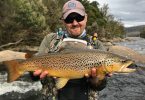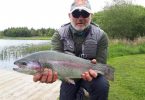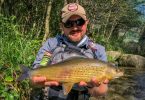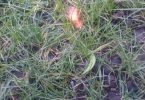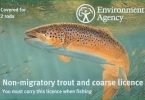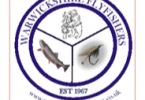Sedges can be encountered throughout the year in various stages of development so they have to be very high on any discerning angler’s list of necessary patterns to copy to deceive the quarry species, be it Grayling or Trout. In the upper reaches of my home river the Dee in North Wales, Sedges hatch at one time or other in any day from April right through to the beginning of November given the right weather conditions and water temperature to coincide.
Adult Sedge patterns are varied to suit the times of the year. Differing stages in the life cycle necessitated the use of Nymphs to copy part of these stages and this is nothing new the success of the Czech nymph as a copy to fish deep needs no introduction. Actual dry imitations of various Sedges can be very successful when the fish are on the Adult Sedge returning to lay its eggs or fluttering to the bankside vegitation after emerging but none more so to my knowledge have been as consistent with the results of the present day use of the emerging Sedge pupa.
In play at the vice during the winter of 2000 having had my head in various authoritative books on Sedges I had created a Sedge pupa / emerger with the use of a dubbing rope and three colours of fine soft SLF that Davy Wooton had given me some time previous, under a CDC pole of six plumes set on the apex of a curved hook shank ensuring that the pupa sat under the surface film in presentation, the prototype was similar in size, shape and colouring to an emerging pupa referred to in the books I read, it took its place in the box in the ‘Try’ section.
In 2001 whilst in Lapland at the Fips Mouche World Championship match, helping out with the Irish team our Guide Carl Holmkvist had taken us into the wild’s onto a River called the ‘Skepptraskan’ during one of the practice sessions, a rather peaty shallow fast running river with pools and glides over a shingle / sand and mixture of volcanic rock bed. We were acutely aware that in August, Sedges would play a major part in the forthcoming match and as Ireland had no Grayling for the team to practice on at home their visit to Wales prior to the trip had been their only encounter with the species. The team fared well with their newly acquired technique of nymphing on the dead drift method with Sedge larval imitations and spirits were high when we reached the Log cabin on the beat for our lunch of fresh toasted cheese and ham sandwiches over and open central fire together with some serious coffee. The weather had been a mixture of heavy showers and rather a cool wind on and off.
During lunch one of the team, ‘DJ’ Byrne mentioned that just before lunch he had noticed a few fish moving on a glide , just breaking the surface and whilst searching the surface for evidence of some form of hatch had noticed in the ray of sunlight against the peaty background of the water a ‘pinky – yellow to cream’ aquatic inhabitant floating past just below the surface , his attempt at securing one for viewing was thwarted by the strength of the current, the collective assumption was that it could be the Sedge pupae emerging. Duly armed with Bugs of a similar colour from the array of boxes at our disposal we set forth to the River and we had decided to split the beat into sections similar to that of the World Championship match and an allotted time of three hours to tackle the beat.
I stood back and watched Peter Driver do great justice to his chosen team of ‘Bugs’ and as he moved up the beat taking fish after fish , from the position I was at I could see the odd fish breaking the surface downstream of him and that not more than a few feet away, most of his fish came as the weighted nymph rose to the surface at the end of the drift.
I decided to follow him on as an experiment in the knowledge that it was possible that ‘DJ’ had seen the Sedge pupa emerging, and found my winter ‘2000’ creation of an emerging
Sedge, aforementioned, in the box. I followed on and in the space of an hour took eight good quality Grayling and a decent Brownie casting a short line upstream, the fish just sucked the offering from the surface film and the CDC on the back of the fly could be watched with ease.
Over the next few days the fly worked again in various places in Lapland but not to the effect it had been on that first outing, there again we were fishing different rivers and differing kinds of water within the beats so I was not about to give up on the pattern as a one day wonder, based on the results of that first wetting.
It is interesting to note at this juncture that the most consistent flies in the winning French, Czech and Finish teams in that World Championship in Lapland were Sedge (Larvae) imitations as can be seen, courtesy of the teams involved, a lot of skill went along with these patterns make no mistake about that!.
All good things come to an end but good things also follow in the main,the start of the Grannom hatch around the middle of April on the Dee is a sight to behold and can last up to two weeks, in the memory bank it is as if the whole world is waking up again the leaves are just opening with a hint of the warmth of spring and the birds in song , this brings on the first serious rise of Trout in the fishing year and a time to be out for a couple of hours either side of midday to coincide with the warmth, sport can be fast and furious and although some of the fish are still a little lean great sport can be had with debarbed hooks for easy release – my efforts in Lapland with the emerger had resulted in a 2001 winter tying of the emerger with a three tone Olive fine SLF dubbing rope with the addition of eyes made from burnt black coloured nylon, with this first serious rise of the season and Grannom in mind, I had also decided to tie the fly reversed on the hook shank so that when presented upstream should reach the water at least facing the right way, head upstream, I couldn’t wait.
The pattern worked well on occasions over several days mid April 2002 and both Trout and out of season Grayling came to hand, the fish were stuffed with the nymph and emerger, I had the colour about right but it was not consistent in its role – remembering about the method once described to me as the ‘NewZeland’ style – back at the vice I tied another emerger this time omitting the CDC and putting just three turns of fine lead wire in the thorax, the next day was a red letter day with the weighted emerger tied on a 50 cm piece of 4lb fluorocarbon onto the bend in the hook of the surface emerger, I was in serious business, the fish did not have to come up as far, although some took the surface emerger others the weighted one with the surface emerger giving early indication of the fishes connection a double whammy!.
The Grannom came and went followed by various other Sedges throughout the year with a great showing in September of quality Grayling, the three tone Yellowy SLF pattern emerger both surface and weighted gave an incredible account of themselves at times throughout the Summer and into the Autumn, and those entrusted to a few close friends gave a similar result enough to make me tie a few dozen of each ready for the next season and to share with the readers something of significant importance to the armoury.
To tie the G.H. Emerger , I used a Bronze mustad 80250 size 12 and 14 hook with Thread to match the chosen colour of the body. Use the thread to create an underbody to a point over the barb of the hook, burn the ends of a short piece of black nylon leaving about 1/16” inbetween. Tie this in and position the eyes on the underneath of the hook shank directly above the hook barb. Place three CDC feathers on top of one another with the tips matching and lay on a flat surface, place another three CDC feathers on top of one another and marry up to form a compact unit. Lay onto the top of the hook shank and tie in 1/8
” towards the hook eye away from the eyes, being careful that the protruding feathers are compatible with the size of the finished fly, wrapping the tying thread around the base of the feathers to form a pole. Trim the surplus and tie base of feathers to secure. Create a dubbing loop on the bend side of the hook to where the eyes are positioned and take the tying thread back to the hook eye. Place in the loop a sparse amount of SLF colour to suit your requirement,dark nearest the hook, lighter in the middle and lighter at the end, using less material down the loop away from the hook so that the rope when spun will give a tapered effect thus giving the body of the fly the same effect, wind this in tight close turns to the hook eye trap in trim the surplus, whip finish and varnish.
To tie the weighted version, do away with the use of the CDC and put three turns of fine lead wire in at the thorax position, this will enable it to cut through the surface film and sink down a few inches.
Gwilym Hughes (APGAI)
You can find a wealth of interesting information on Gwilym’s background, along with details on his tutorial videos and tutoring services at: http://www.gwilymhughes.com
Got a flyfishing question you’d like to ask Gwilym? Please email us and we’ll pass it on.

